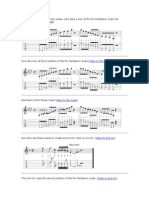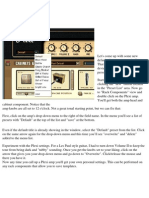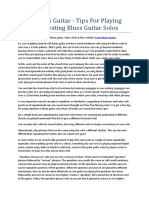0 ratings0% found this document useful (0 votes)
166 viewsPentatonic Song Blue Guitar Blues
Pentatonic Song Blue Guitar Blues
Uploaded by
Jonas9814The document discusses a guitar lesson on playing the song "Blue Guitar Blues". It explains that the song uses a pentatonic scale melody over chord progressions. The instructor records the chord progression using a looper pedal, then teaches the melody, which is based on notes from the G minor pentatonic scale. The melody is played over the recorded chords to demonstrate how they fit together in the 12 bar blues form.
Copyright:
© All Rights Reserved
Available Formats
Download as TXT, PDF, TXT or read online from Scribd
Pentatonic Song Blue Guitar Blues
Pentatonic Song Blue Guitar Blues
Uploaded by
Jonas98140 ratings0% found this document useful (0 votes)
166 views2 pagesThe document discusses a guitar lesson on playing the song "Blue Guitar Blues". It explains that the song uses a pentatonic scale melody over chord progressions. The instructor records the chord progression using a looper pedal, then teaches the melody, which is based on notes from the G minor pentatonic scale. The melody is played over the recorded chords to demonstrate how they fit together in the 12 bar blues form.
Original Description:
kjjk
Copyright
© © All Rights Reserved
Available Formats
TXT, PDF, TXT or read online from Scribd
Share this document
Did you find this document useful?
Is this content inappropriate?
The document discusses a guitar lesson on playing the song "Blue Guitar Blues". It explains that the song uses a pentatonic scale melody over chord progressions. The instructor records the chord progression using a looper pedal, then teaches the melody, which is based on notes from the G minor pentatonic scale. The melody is played over the recorded chords to demonstrate how they fit together in the 12 bar blues form.
Copyright:
© All Rights Reserved
Available Formats
Download as TXT, PDF, TXT or read online from Scribd
Download as txt, pdf, or txt
0 ratings0% found this document useful (0 votes)
166 views2 pagesPentatonic Song Blue Guitar Blues
Pentatonic Song Blue Guitar Blues
Uploaded by
Jonas9814The document discusses a guitar lesson on playing the song "Blue Guitar Blues". It explains that the song uses a pentatonic scale melody over chord progressions. The instructor records the chord progression using a looper pedal, then teaches the melody, which is based on notes from the G minor pentatonic scale. The melody is played over the recorded chords to demonstrate how they fit together in the 12 bar blues form.
Copyright:
© All Rights Reserved
Available Formats
Download as TXT, PDF, TXT or read online from Scribd
Download as txt, pdf, or txt
You are on page 1of 2
[MUSIC] So that was a pentatonic scale.
Now we're going to take
a look at a song that uses the pentatonic scale as a melody. Songs often use pieces
of scales as melody. Over some kind of harmony. Usually the harmony is some kind of
chord. Let's take a look at the chart for
this song. The name of this song is
the Blue Guitar Blues. This song is written in
what we call blues form, which is part of a great
American tradition of music. The song uses power cords. It uses quarter notes,
eighht notes,
half notes, and whole notes. All of which we've covered. Now on guitar in this
level, it's very difficult to play both the
melody and the chords at the same time. So there are a couple of different
ways we can get around that. The easiest of course is to get a friend
to play the chords while you play the melody, or you can play the chords
while your friend plays the melody. Another way,
which we're going to do right now, is I'm going to use a little device,
a pedal called a looper. And with this looper,
I'm going to play the chords first. And then after I have those recorded,
I'm going to go back and play the melody over those chords. So that way, we get
both melody and
harmony playing at the same time. Let's take another look at the chart. Now here we
see the first thing
that we should pay attention to is what we call the time signature. Now this is a
simple tune in 4 4. Most important thing for you to remember is that a tune in 4 4
has
four beats in each measure. We're going to start by
layering the chords. So, we have a G power chord, we have a C
power chord, and we have a D power chord. There are only three chords in the whole
song, that played in different places and they're held for
different lengths of time. We can see the slashes mean that the chord
is played for each of those beats. Now I'm going to use my looper, and
I'm going to start playing a chord. I'm going to play one downstroke for
each slash. Now I'm going to set my
metronome at 66 beats a minute. That's a good tempo. It'll give you enough time
to change to the next chord. [SOUND]
[SOUND] One, two, three, four and G, two, three, four. One ,two, three, four and G,
two, three. [SOUND] Four, and one, two, three, four. And C, two, three, four.
And one, two, three, four. And G, two, three, four. And one, two, three, four. And
D, two, three, four. And C, two, three, four. And G, two, three, four. And D, two,
three, four, and. So there I have the chords and
I've recorded for my song. And you can see that I
played a G power chord, G5. Then I changed to a C power chord,
right here. Then I changed back to a G power chord, G5. [MUSIC] Then I switched to
the d for four beats,
then I switched to the C for four beats. And now we're back at G. And then D.
[MUSIC] Now, we're going to talk about the melody. We have the chords recorded.
We're going to talk about the melody for
this song, Blue Guitar Blues. The melody is made up of notes
from a pentatonic scale. In this case it's notes from
the G-minor pentatonic scale. Now we've learned our
pentatonic scale previously and we're going to put that to good
use now by playing a melody. The melody often times for
blues songs is rooted in the pentatonic scale or the blue scale
which very close to pentatonic scale. Here we go one, two three, four and [MUSIC]
Let's take a look at the melody. If we look at the measure one, we'll see remember
that pentatonic
scale that we learned it sounded like. [MUSIC] Quick pentatonic review. [MUSIC] If
we look at the first measure,
it's actually just an ascending. [MUSIC] And descending minor pentaton. [MUSIC]
Landing on the G and
holding the G for four beats. That's a whole-note G. Play that again. [MUSIC] Now
if we look at measure three. It's actually a repetition of measure one. We actually
play exactly
the same thing one more time. [MUSIC] When we get to measure five we have
that C chord, the C five chord. It's a slightly different melody. Again, using
parts of the same scale. And ending again on a whole note, C. Sounds like this.
[SOUND] One more time. [SOUND] One, two Three, four. Measure seven, we go right
back to the original melody
that we played in measure one and two. Sounds like this again. [MUSIC] We get to
measure nine. Slightly different melody again. This one uses quarter notes. On an
F.
One, two, three, [MUSIC]. The quarter notes are followed by
a descending pentatonic scale. So it's like one, two, three, four [MUSIC]. The
following measure has
the same rhythmic pattern. This time, it's on a C. Two quarter not Cs followed by
a descending minor pentatonic scale. One, two, three, four. One more time. One,
two, three, four,
one, two, three, four. Now for measure 11 we go right
back to the original melody. [MUSIC] Which is part of the ascending and
descending scale only this time for measure 12 we go two half notes. The D held for
two beats, and
the F held for two beats. Sounds like this one, two, three,
four, and one, two, three, four, and. The whole melody again sounds like this. One,
two, three, four. One, two, three, four. One, two, three, four. One, two, three,
four. One, two, three, four, one, two, three, four, one, two, three, four, one,
two, three, four, one, two, three, four, one, two, three, four, one, Two, three,
four, one, two, three, four, one, two, three, four. [SOUND] And that's our blue
guitar blues. The melody's based on the pentatonic, and it uses the power chords
that we learned
from the chord section of the course.
You might also like
- Microsoft .NET FrameworkDocument12 pagesMicrosoft .NET FrameworkSiddharth SrivastavNo ratings yet
- Optimizing Windows 10 Services For Increased Performance - Discourse - Pi64.winDocument16 pagesOptimizing Windows 10 Services For Increased Performance - Discourse - Pi64.winjuakinuxNo ratings yet
- Grade 5 English Poetry Project PDFDocument2 pagesGrade 5 English Poetry Project PDFPenny NakhleNo ratings yet
- GT-100 Preset Patch ListDocument8 pagesGT-100 Preset Patch Listpicaaman100% (1)
- Marc Guitar - More Slow Blues Licks in C7Document3 pagesMarc Guitar - More Slow Blues Licks in C7andreas papandreouNo ratings yet
- Blues Guitar Lesson - F BLues LicksDocument2 pagesBlues Guitar Lesson - F BLues LicksjjeanNo ratings yet
- EXAMPLE 17-1: Lesson 17 - Hammer-Ons, Pull-Offs, and "Tweedlies"Document3 pagesEXAMPLE 17-1: Lesson 17 - Hammer-Ons, Pull-Offs, and "Tweedlies"Anthony D. FrattoNo ratings yet
- Blues Licks (Section 1: Bends) : Types of Bends and ExercisesDocument3 pagesBlues Licks (Section 1: Bends) : Types of Bends and ExercisesNeil JamesNo ratings yet
- Collection of 101 Scathing Humor ColumnsDocument215 pagesCollection of 101 Scathing Humor ColumnssbmemonNo ratings yet
- Eddies BluesDocument3 pagesEddies BluesPiano EasyNo ratings yet
- Give People More Than They Expect and Do It CheerfullyDocument11 pagesGive People More Than They Expect and Do It CheerfullyEric P 蔡金浩No ratings yet
- 15 Easy Blues Guitar Chords To Learn MusicRadarDocument12 pages15 Easy Blues Guitar Chords To Learn MusicRadarnukke1No ratings yet
- GT-100 Parameter E02Document38 pagesGT-100 Parameter E02MarcosSilvaNo ratings yet
- Awesome Blues Guitar Licks GuideDocument5 pagesAwesome Blues Guitar Licks GuideDaniel CamposNo ratings yet
- Wise Words: A Collection of Frugal Quotes: PulsiferDocument2 pagesWise Words: A Collection of Frugal Quotes: PulsiferAlexander SaliyutiNo ratings yet
- Web Developers & The Open Web - Survey ResultsDocument53 pagesWeb Developers & The Open Web - Survey ResultsJay PatelNo ratings yet
- Wireless Debugging Through ADB in Android Using WiFi PDFDocument11 pagesWireless Debugging Through ADB in Android Using WiFi PDFVinnie TendereNo ratings yet
- MUSIC BOX BLUES CHORDS by Trans-Siberian Orchestra @Document2 pagesMUSIC BOX BLUES CHORDS by Trans-Siberian Orchestra @watchman29No ratings yet
- 'STUCK IN A RUT - The Rudiments' by Guy Pople PDFDocument9 pages'STUCK IN A RUT - The Rudiments' by Guy Pople PDFQuorum AcousticsNo ratings yet
- Webex 1 BluesDocument2 pagesWebex 1 Bluesdddd1111qqNo ratings yet
- Family Chords Improvisation FormulaDocument3 pagesFamily Chords Improvisation FormulaJoel Gabriel Navajas PregonerNo ratings yet
- Killer Lick - Starting A Blues Solo TAB PDFDocument1 pageKiller Lick - Starting A Blues Solo TAB PDFcursos fenixNo ratings yet
- ACDC - Touch Too MuchDocument22 pagesACDC - Touch Too MuchQuinteroJhon100% (1)
- SpellingOutBluesChordsGuide PDFDocument6 pagesSpellingOutBluesChordsGuide PDFAntonio ZappuloNo ratings yet
- Call and Response NR PDFDocument1 pageCall and Response NR PDFRosa MerinoNo ratings yet
- Ebook - Guitar Rig - Tutorials by Jerry McphersonDocument11 pagesEbook - Guitar Rig - Tutorials by Jerry McphersonJoe MassoNo ratings yet
- Mark John Sternal - Easy Guitar TricksDocument18 pagesMark John Sternal - Easy Guitar TricksElisa PortillaNo ratings yet
- Marc Guitar - C7SlowBlues (Clapton Style) TABDocument3 pagesMarc Guitar - C7SlowBlues (Clapton Style) TABandreas papandreouNo ratings yet
- Gimme ShelterDocument7 pagesGimme ShelterCurtis StrongNo ratings yet
- Blues Chord Progression For GuitarDocument3 pagesBlues Chord Progression For GuitarWerner_Welgens6232No ratings yet
- Learn A Complete Blues Solo Licks For Each Chord Change!Document1 pageLearn A Complete Blues Solo Licks For Each Chord Change!pantopitaNo ratings yet
- Module 10 - Minor Blues Progression Dan Amerson: All Rights ReservedDocument5 pagesModule 10 - Minor Blues Progression Dan Amerson: All Rights ReservedhogarNo ratings yet
- Playing More Interesting Blues Guitar SolosDocument2 pagesPlaying More Interesting Blues Guitar Solosgraham9754No ratings yet
- BLUES DominationDocument25 pagesBLUES DominationAlessandro ValentimNo ratings yet
- Blues Guitar Lesson - G Shuffle LicksDocument3 pagesBlues Guitar Lesson - G Shuffle Licksjjean100% (4)
- 8 Blues Guitar Chords To KnowDocument1 page8 Blues Guitar Chords To Knowjovan.filipovicNo ratings yet
- Blues Guitar SoloDocument12 pagesBlues Guitar SoloBNo ratings yet
- A SAUCERFUL OF SECRETS ALBUM TAB by Pink Floyd at Ultimate-GuitarDocument6 pagesA SAUCERFUL OF SECRETS ALBUM TAB by Pink Floyd at Ultimate-GuitarMigliorino Carmelo100% (1)
- Chords Workshop - Guitar LeagueDocument44 pagesChords Workshop - Guitar Leaguexufoo100% (1)
- Harmony: I: Major and Minor TriadsDocument18 pagesHarmony: I: Major and Minor Triadsmadlad100% (1)
- JamPlay 20 Rock and Blues-JamTracksDocument13 pagesJamPlay 20 Rock and Blues-JamTracksBobNo ratings yet
- GUITAR Triads Are Three Note ChordsDocument5 pagesGUITAR Triads Are Three Note ChordsJane Limsan PaglinawanNo ratings yet
- Guitar Chord TipsDocument3 pagesGuitar Chord TipsVickeybird7744No ratings yet
- Eric Johnson Cliffs DrumsDocument9 pagesEric Johnson Cliffs DrumsAKSAR HIBURNo ratings yet
- Guitar PDFDocument40 pagesGuitar PDFRohit AttriNo ratings yet
- Slow Blues A7 - Licks 1 - 5 PDFDocument2 pagesSlow Blues A7 - Licks 1 - 5 PDFbohemianNo ratings yet
- Electric Guitar Tricks: Hammers-OnsDocument6 pagesElectric Guitar Tricks: Hammers-OnsHerry TroNo ratings yet
- HarmonicaDocument8 pagesHarmonicajaydinNo ratings yet
- 10 Blues LicksDocument6 pages10 Blues LicksBNo ratings yet
- How To Sound Like Eric JohnsonDocument1 pageHow To Sound Like Eric Johnsong4277No ratings yet
- Excellence QuotesDocument3 pagesExcellence QuotesKingsley St John EnninfulNo ratings yet
- Bass LinesDocument4 pagesBass LinescpcromNo ratings yet
- Hotel California Tab by EaglesDocument3 pagesHotel California Tab by EaglesCharley Labicani BurigsayNo ratings yet
- How To Transpose Music I Definition & Types of Transposition Transposing ChordsDocument4 pagesHow To Transpose Music I Definition & Types of Transposition Transposing ChordsIsrael Mandujano Solares0% (2)
- Arpeggio Patterns For PracticeDocument1 pageArpeggio Patterns For Practiceadilio hernandezNo ratings yet
- Matt Warnock Guitar: Your Online Guide To Playing Better Jazz GuitarDocument46 pagesMatt Warnock Guitar: Your Online Guide To Playing Better Jazz GuitarNattapong keawsaichooNo ratings yet
- Guitar Lesson World - ModesDocument3 pagesGuitar Lesson World - Modesdrthslyr50% (2)
- More Than A FeelingDocument4 pagesMore Than A Feelingapi-3742340No ratings yet
- The Jazz Guitarist's Handbook: An In-Depth Guide to Chord Symbols Book 1: The Jazz Guitarist's Handbook, #1From EverandThe Jazz Guitarist's Handbook: An In-Depth Guide to Chord Symbols Book 1: The Jazz Guitarist's Handbook, #1No ratings yet
- Listening To MusicDocument10 pagesListening To MusicGonzaloNo ratings yet
- Theory: DipmusDocument7 pagesTheory: DipmusJonas9814No ratings yet
- Inggeris Rationale JonasDocument1 pageInggeris Rationale JonasJonas9814No ratings yet
- Do Not: Namecsfinal Nameppfinal 01name Etc.Document3 pagesDo Not: Namecsfinal Nameppfinal 01name Etc.Jonas9814No ratings yet
- Ess Ia JonasDocument9 pagesEss Ia JonasJonas9814No ratings yet
- 013-4600 02D Sisd PDFDocument4 pages013-4600 02D Sisd PDFJonas9814100% (1)
- Practice - Passive Voice, Simple Present 2Document1 pagePractice - Passive Voice, Simple Present 2CruzJavierNo ratings yet
- All About Glass BeadsDocument15 pagesAll About Glass BeadsLuciacighir100% (2)
- Part and PendereckiDocument16 pagesPart and PendereckiAlexander Formosa100% (1)
- Cantus Firmus Principles of Melodic MotionDocument2 pagesCantus Firmus Principles of Melodic MotionAnonymous Jy9y9NMN100% (1)
- Andy Pollock ResumeDocument1 pageAndy Pollock Resumeapi-247830243No ratings yet
- Liten Kofta 3-6 Months - FinalDocument4 pagesLiten Kofta 3-6 Months - FinalAna SilvaNo ratings yet
- Flower Hairclip 1Document6 pagesFlower Hairclip 1Georgia StewartNo ratings yet
- Basuki AbdullahDocument11 pagesBasuki AbdullahNenden MaryaniNo ratings yet
- ValenciaDocument4 pagesValenciaAndrés AcPzNo ratings yet
- Unit Test 2017Document4 pagesUnit Test 2017EvernickEdquilaMakabentaNo ratings yet
- Verbalizers in TrioDocument16 pagesVerbalizers in TrionilracebNo ratings yet
- Descriptive Paragraph About ThingDocument1 pageDescriptive Paragraph About ThingSusi Adrina KayNo ratings yet
- Languages - (eBook-PDF) Greek Language - AdjectivesDocument8 pagesLanguages - (eBook-PDF) Greek Language - Adjectivesdanutza277No ratings yet
- Seven Star Mantis FormsDocument3 pagesSeven Star Mantis FormsFaarenNo ratings yet
- WH QuestionsDocument4 pagesWH Questionsgeetkumar18100% (1)
- ELGAR, E. - Sea Pictures: Polonia: Pomp and Circumstance Marches Nos. 1-5 (A. Coote, Hallé Orchestra, M. Elder)Document18 pagesELGAR, E. - Sea Pictures: Polonia: Pomp and Circumstance Marches Nos. 1-5 (A. Coote, Hallé Orchestra, M. Elder)Fernando Barbosa0% (1)
- Forbidden City AssignmentDocument9 pagesForbidden City AssignmentArif AhmedNo ratings yet
- Jazz Musician Wynton Marsalis - Time Magazine - William Lee AdamsDocument3 pagesJazz Musician Wynton Marsalis - Time Magazine - William Lee AdamsNikkiWootonNo ratings yet
- Grammar - Parts of SpeechDocument17 pagesGrammar - Parts of Speechcaptainnkumar1043100% (1)
- Adolf Loos-The Life-The Theories-Villa MuellerDocument58 pagesAdolf Loos-The Life-The Theories-Villa MuellerIulia Ion50% (2)
- Bookshelf Sorted by Author PDFDocument1 pageBookshelf Sorted by Author PDFbeowulf_exNo ratings yet
- Marathi Organ Is at Ions and MandalsDocument6 pagesMarathi Organ Is at Ions and MandalsAtul ShindeNo ratings yet
- Manual Brother XL 5130Document77 pagesManual Brother XL 5130NIUKNo ratings yet
- The Royal Landscape, Windsor Great Park Announces 'Summer Season of Arts'Document2 pagesThe Royal Landscape, Windsor Great Park Announces 'Summer Season of Arts'RanuLimbodiyaNo ratings yet
- Troubadour MusicDocument9 pagesTroubadour Musicstahl_cameronNo ratings yet
- Andre Bazin, The Ontology of The Photographic Image From His Book What Is Cinema Vol. IDocument8 pagesAndre Bazin, The Ontology of The Photographic Image From His Book What Is Cinema Vol. IAnkit LadiaNo ratings yet
- Simple Present Tense Booklet TuteeDocument8 pagesSimple Present Tense Booklet TuteeSimay38% (8)
- College Humor - "Look at This Instagram (Nickelback Parody) "Document2 pagesCollege Humor - "Look at This Instagram (Nickelback Parody) "Lyubov FateevaNo ratings yet





























































































